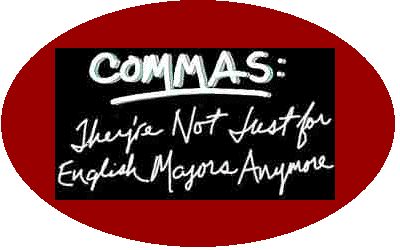
By Joseph Sigalas, Ph.D.
source: (http://crosswaterfarm.com/commas)

|
By Joseph Sigalas, Ph.D. source: (http://crosswaterfarm.com/commas) |
|
|
YOU MUST HAVE A REASON FOR EACH COMMA YOU USE. |
IE - Introductory Elements
An introductory
element is a word, phrase, or clause before the main part of the sentence.
It usually tells us something about the main clause.
If we cannot control our tempers, we may have to bite those mimes.CE - Contrasting ElementsOn the other hand, they may bite us first.
We were suspicious of the fried green tomatoes.(Fried green tomatoes may taste good, but green fried tomatoes might make you sick). OR, try inserting and between the adjectives. If and works without changing the meaning, use a comma. If and doesn't work, don't use a comma.
We were suspicious of the fried and green tomatoes.This sentence says that some tomatoes were fried, while others were green. That's not the same as "fried green tomatoes," so don't use a comma.
NRE - Non-Restrictive Elements
These elements are the ones known, often misleadingly, as "the
part you could just take out": parenthetical comments, direct address, appositives,
transitional words and phrases, etc.
He begged to run into the airplane propeller, an act which would have dramatically shortened his life expectancy.The clowns were scary, especially the sarcastic ones.
Two other
situations you probably already know:
Special Case: Commas With Quotations and Other Punctutation Here are four tips: 1) Use commas to set quotes off from the words used to introduce or identify the source. The cartoonist shouted, "I quit!"2) Do NOT use a comma, however, when the sentence includes MORE THAN the quote and the words used to introduce it: The cartoonist sang "I love myself" before she left for beauty school.3) Do NOT use a comma when a quotation is introduced by "that." 4) When
a quotation is part of an introductory or other type of clause requiring a
comma, place the comma INSIDE
My favorite song is "I Love You, You Love Me", but I haven't told anyone yet.
When the nutty captain shouted "Pancakes for everyone," the crew went crazy for joy. |
© 2000-2008 Joseph Sigalas / revised 03/2008